13+ Push Notification Best Practices to Skyrocket Your Sales
The new year is around the corner, and we bet you’re about to release a push notification campaign. However, before you start, you should sit down and see whether your campaign is ready or not.
If yes, congratulations!
If not, that’s okay, as we’re here to help you!
Pulling from our experience in this field, we have listed 13+ best practices to help you craft a successful push notification strategy. Without any further ado, let’s dive in!
13+ push notification best practices to skyrocket your sales
1. Ask for permission before sending
No matter how perfect your push notification strategy is, it’s worthless if users haven’t enabled you to send. Nevertheless, 65% of users return to an app within 30 days when push notifications are allowed, so it’s critical to persuade users to opt in.
Instead of asking users to enable push notifications immediately after launching your app for the first time, you should build a relationship with them first. They need to trust your product/service and know that you won’t take advantage of having access to notifications.
Allow users to experience your app, and only in a later session, ask them to accept push notifications. For instance, E-commerce apps may want to ask for permission after a purchase event. This provides a chance for you to show why push notifications are valuable. In this case, the value would be alerts on the shipment of that product.
Let’s see how the Conquest mobile game asks for permission. It lets players experience the app before asking them to enable notifications. Game players complete different tasks to increase their stats and level up. Only after players have leveled up for the first time, does the game ask them to enable notifications.
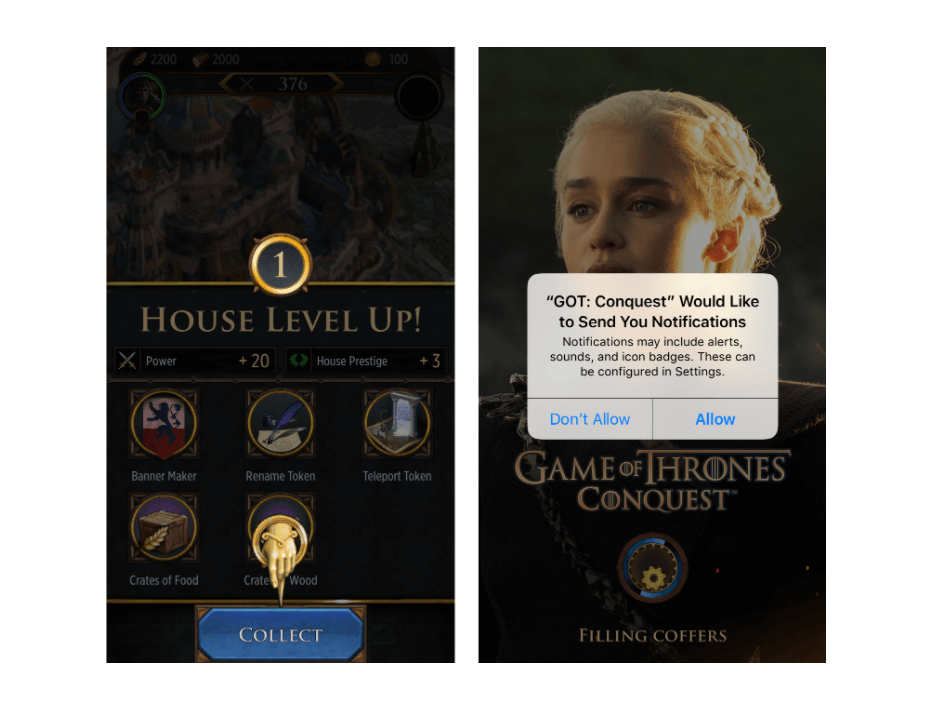
2. Tell users what information they’ll receive
iOS often sends generic messages, saying, “Company X would like to send you notifications.” However, this message only focuses on what the company wants from customers, not on what the customer will gain.
For some apps, like news or social media apps, users can make reasonable guesses on the type of information they’ll see in notifications. However, it’s harder to guess the content of the push notifications sent by an entertainment or retail app.
So, tell people what push notifications will be about. By doing so, you can make users understand whether they need them, as well as increase the perceived credibility and trustworthiness of your app.
For instance, Night Sky - an AR planetarium app - explains which notifications will be about (stargazing conditions, object rise times, ISS flyovers, etc.). Providing this information before asking people to enable notifications lets users make an informed decision.

3. Personalize your push notifications
Personalized push notifications ensure that you’re targeting the right users at the right time. They include creativity, delivery times, frequency, location, and content type. That means you need to segment your users into various groups.
You should also address users by name whenever possible and include other information relevant to your CTA. For instance, you could include the flight number and time if you’re announcing a delay or include order numbers when updating users on their upcoming delivery.
Waze does a great job by sending out this notification to people in certain geolocation:
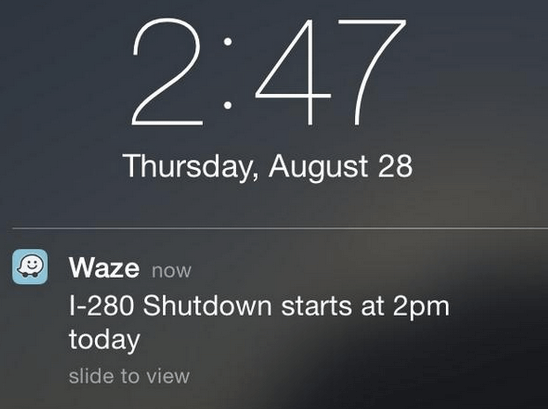
When receiving this notification, you know not to take the I-280 from tomorrow or on the way back home.
You can also personalize push notifications based on the user lifecycle. That means identifying when users are most likely to need a notification to complete the desired action. Suppose your primary goal is to keep users engaged for longer and increase LTV (Customer Lifetime Value). In that case, it’s vital to personalize your push notifications and engage users at the right time in their user lifecycle.
4. Build a relevant context
Building a relevant context is vital, as no one wants to receive irrelevant and disturbing push messages. However, a study by Urban Airship shows that “one-third of the companies that gather user preference don’t actually use it to tailor their content”.
According to Ron Rogowski and Stephen Powers from Forrester, you should collect the following three types of data to master contextualization:
- Demographic data (who the user is)
- Historical data (what the user has done)
- Situational data (what is happening with the user now)
Upon collecting the data, the next step is user segmentation depending on your key value proposition.
For example, if you’re running a celebratory offer on Christmas Day (key value proposition), then you’d mine the user who may show interest (historical data). Next, you’d check if the given situation is conductive to send, such as the time of the day (situational data). Then, you’d ensure that you don’t end up sending it to users outside of the US (demographic data).
The idea here is to send push notifications to people you believe can use it. If your users cannot derive any value from your push messages, you’re driving them away.
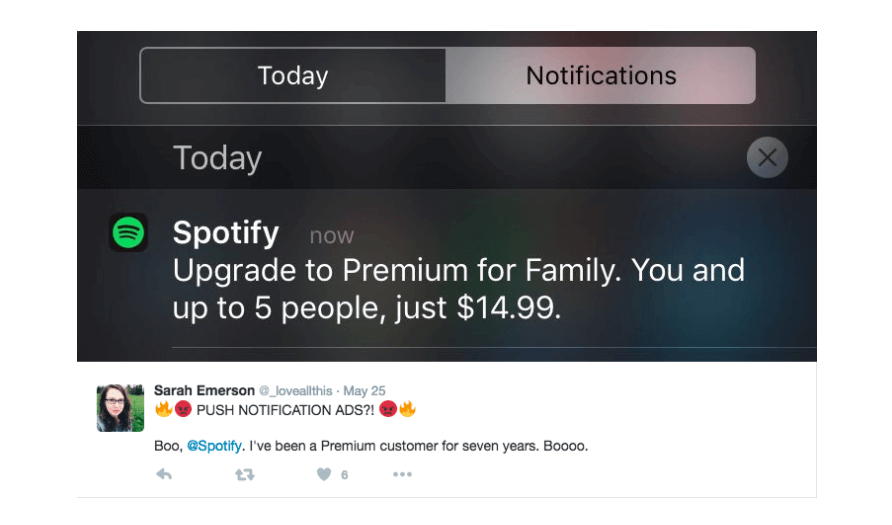
5. Pay attention to your message length
By default, iOS allows a character limit anywhere between 150-230 characters, while it’s anywhere between 450-650 characters for Android.
Nevertheless, if you want to get the best response to your push notifications, we strongly recommend a message which isn’t longer than 40-50 characters. It’s been observed that brief, crisp, and succinct messages get the job done better than lengthy phrases, which users might tune out.
6. Boost clicks with curiosity
As a matter of fact, one of the most powerful tools in people’s arsenal is curiosity.
Here’s the deal: All your push messages come with a clear preview. Thus, if you want more clicks, you will need to make your users curious about what’s on the other side of the link.
You’ll be mostly working to create clickbait-y titles and notifications. Actually, many marketers are dead set against clickbait. We say that there is nothing wrong with clickbait as long as it is not misleading. In other words, as long as it is not false advertising, everything is fair game.
Have a look at the example from Curiosity Stream:
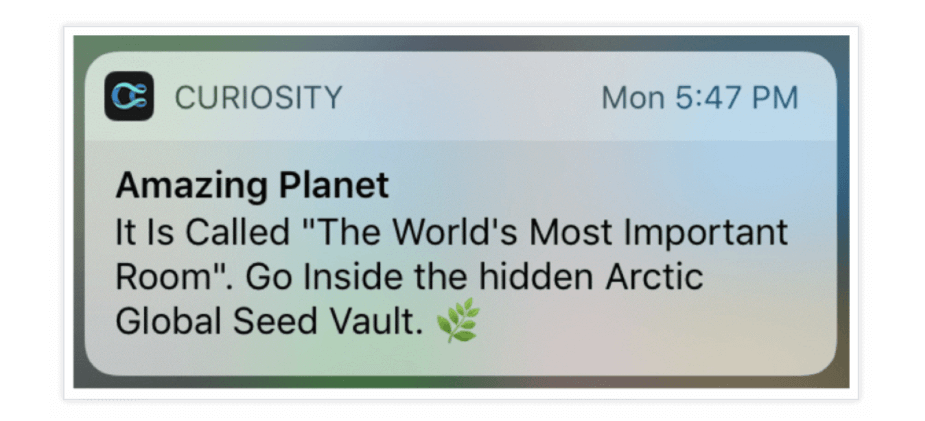
This push notification is deliberately vague. It raises so many questions that recipients want to click on to find out more about “Arctic Global Seed Vault.” Why is it hidden? What are they hiding? Is that where they’re storing the aliens?
Who knows? Go check it out!
If you aren’t convinced yet, look at this one by Wall Street Journal:
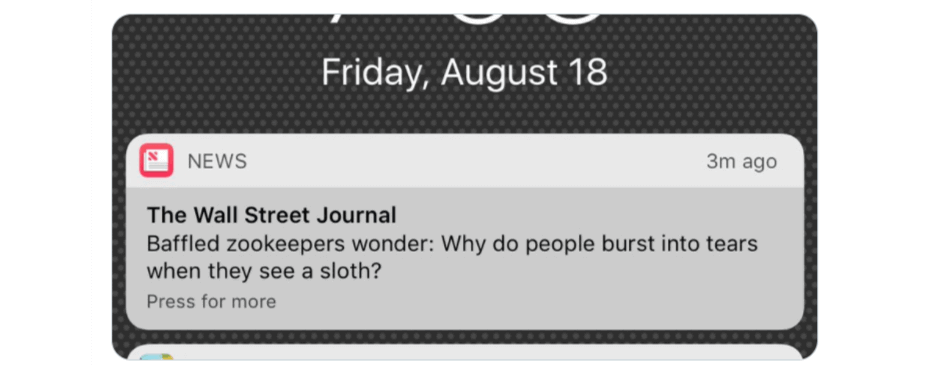
Wait! People burst into tears when they see a sloth? Why?
You’ll know the answer when you click the notification! That’s what the Wall Street Journal wants you to do.
7. Create a sense of urgency
Adding urgency is not just applied for push notification; it is also a major component of almost all successful direct response campaigns.
Urgency can nudge users into taking action, and it is an excellent way of boosting conversions.
However, don’t try to force urgency into a conversation with your users. Instead, try to understand a specific pain point and then find a way for your business to fit in.
Below is a nice example from OpenTable:

There is often a lot of pressure on every couple to make it “special” on Valentine’s Day. It’s reasonable to add a 5-day waiting period for a table reservation at a nice restaurant.
The push notification from OpenTable is simple. It is even labeled a “reminder” so there is no pretense. However, it is still urgent, and the notification itself can be really useful to a lot of people.
8. Stand out with rich media
We all know the saying, “a picture is worth a thousand words,” which holds water even in the push notification field. Studies show that your mind can process an image 60,000 times faster than text. Thus, rich push notifications prove to be very effective!
By implementing rich media, you can add a wow factor to your push notifications. But you should keep in mind the following things:
-
On iOS, restrict images to 1038px X 1038px. Images taller than 1038px can be scaled down with padding to give the image a 1:1 or a square appearance. We recommend using an image of 1038px wide, along with any number lesser than that for the height.
-
On Android, use images that are between 800px and 1038px wide. It’ll help when you maintain a landscape orientation to images as Android OS crops images to a 16:9 ratio, depending on each device.
9. Use emojis wherever you can
Emojis can be a huge help in boosting engagement. According to studies, certain emojis can increase click-through rates for your campaigns. You should avoid emojis that can be interpreted incorrectly or any that disrupt your message flow.
If you don’t replace a word with an emoji, it should typically be placed before and/or after the message. Emojis are often used at the end of a sentence to drive home the meaning of your messaging.
For example:
Time to order dinner 🍕
Your driver has arrived 🚗
Find out if you’re a winner 🏆
Get 25% off your next order 💰
New comments on your page ✋
10. Avoid sending notifications in bursts
Has someone ever repeatedly rung your doorbell? This is the effect that notifications in bursts can have within an interface. Receiving many push notifications in a short interval can overwhelm and irritate users, which causes them to turn off notifications (or, even worse, delete your app).
Rather than fill your user’s screen with a number of notifications, send fewer notifications in a meaningful way. If you have more than 5 push notifications to send at once, combine them into a single message. Shift your focus to quality over quantity, and you’ll be sure to see increased user satisfaction.
For example, when several users like your photo, Instagram will bundle notifications. In this case, instead of sending 11 separate push notifications, Instagram sent one with the names of two users along with a numeric count of the others.
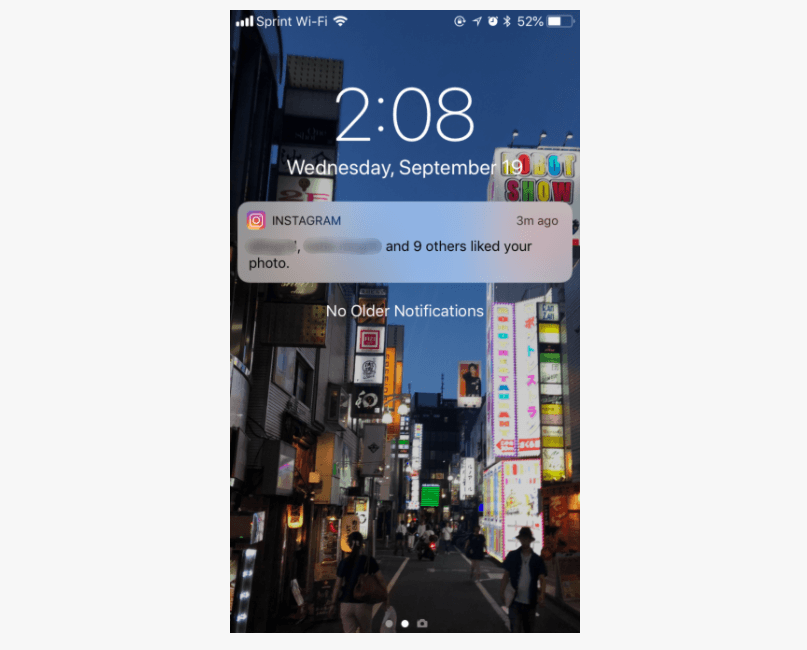
NOTE: iOS 12 makes it simple to deal with burst notifications by grouping all push notifications from one app into a single stack. Nevertheless, combing through 10 similar notifications is boring and irritating. Don’t just rely on the operating system to deal with burst notifications for you.
11. Think about when to send push notifications
With users across the world living in various time zones and having different hobbies, they don’t all tend to engage with your push message at the same time. So, you need to make sure that you are sending your notifications at the best times for users.
Typically, there are two delivery options for your push notifications: Sending them immediately and Scheduling to send them later.

Sending push notifications immediately makes sense whenever you have an urgent message to send to your users. For instance, if companies had breaking news or if an airline had to cancel a flight, they’d want the people affected to be notified as soon as possible.
The scheduling option should be used if your push notification is based on users’ time zones. If you were running a sale that would end at midnight in each time zone, you may want to send reminders at 5 p.m in each time zone, otherwise, some users may be getting notifications while they are sleeping and never see them.
12. Reactivate dormant subscribers
Dormant subscribers gradually reduce your profitability without you even realizing it. However, if you can reactivate them, those subscribers can bring in a ton of extra revenue.
QuizUp, a mobile trivia game, reactivated its dormant players with this ingenious message.
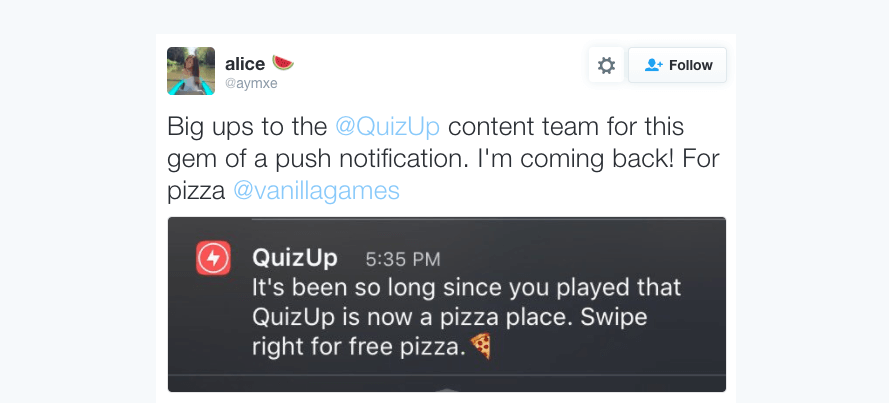
Typically, the idea behind a re-engagement campaign is to remind users of the value of your business before they churn. In most cases, that’s a good approach, but it can get a bit repetitive from the recipient’s point of view.
In the QuizUp example, the recipient surely remembers why they downloaded QuizUp. It is a casual trivia game, not a service or marketplace. The user does not need a discount to regain interest in the game - a gentle reminder could be enough.
This message reminds the user about QuizUp in an original way. There is a chance that the user will remember what they liked about the app in the past and give it another try. That works more effectively than stating the obvious in a standard “hey, we miss you!” reactivation message.
13. Make it easy to turn off notifications
There are multiple reasons why users decide to turn off push notifications:
- They receive too many notifications overall
- Your push message is less relevant or important to them than it once was
- They find them distracting
No matter the reason, you should never try to hide this option from your recipients. This is deceptive, decreases trust in your brand and application, and provides users with all the more reasons to delete your app.
Turning off push notifications should be quick and straightforward. Allow users to edit their notification preferences within your app, so they are not forced to go to their phone’s native settings. In addition, place this option in the Settings section of your application to meet users’ expectations and ensure findability.
14. Don’t forget to A/B test
Let’s say you have delved into your user data and cooked up what, by all indications, should be a high-converting push notification strategy. But you shouldn’t stop there.
A/B testing lets you test your audience’s reactions to various push messages. By testing what works, you can analyze your results and make necessary changes to your strategy. You should A/B test only one variable at one time to know exactly what is influencing the results.
For instance, Notification A has its own title, message, and image. Notification B could have the same message and image, but a different title. By testing these titles against each other, you can determine how the different titles might impact engagement and conversions.
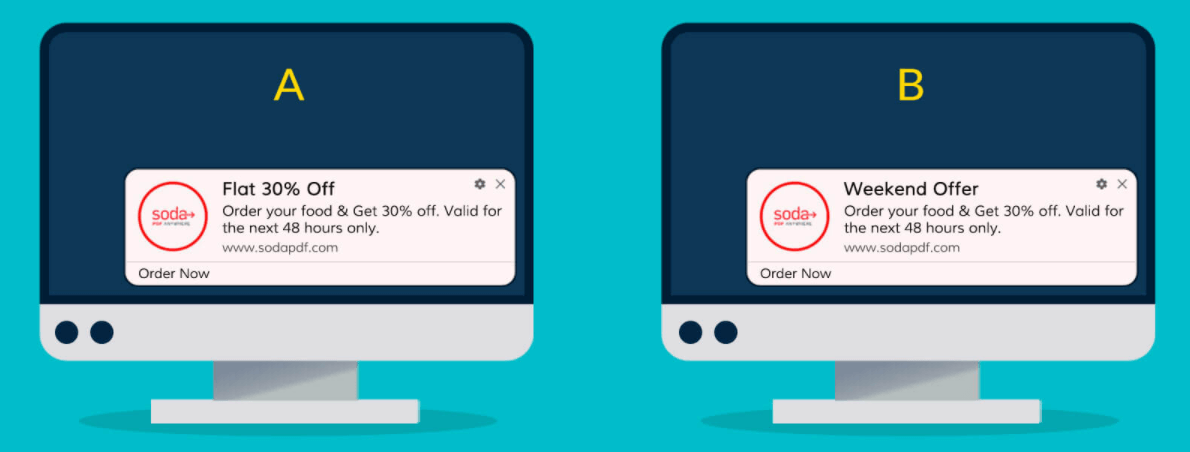
15. Measure your results
Like with every other aspect of your marketing strategy, your push notifications should be measured and optimized over time.
You can set different KPIs that link back to your business goals, such as LTV, engagements, and ROAS (Return on Advertising Spend). You can also request user feedback in order to find out how well your push notifications are received.
The bottom line
That’s all for this article!
The time to take action is right now! Don’t forget to apply these push notification best practices in your next campaigns.
And let us know if you think they are helpful. See you later in our next guides!
New Posts






